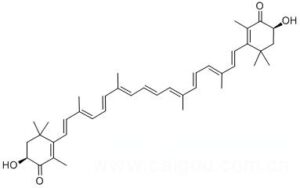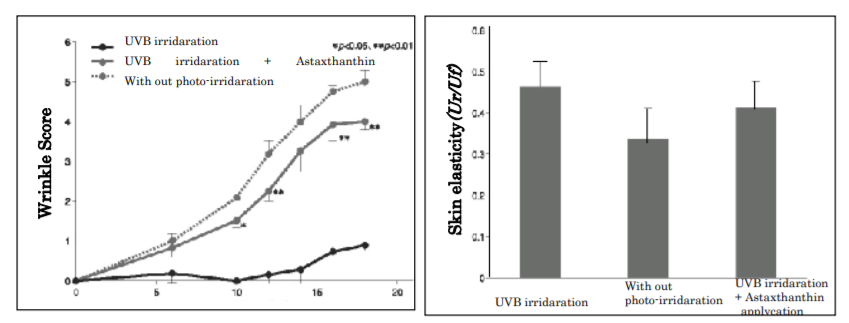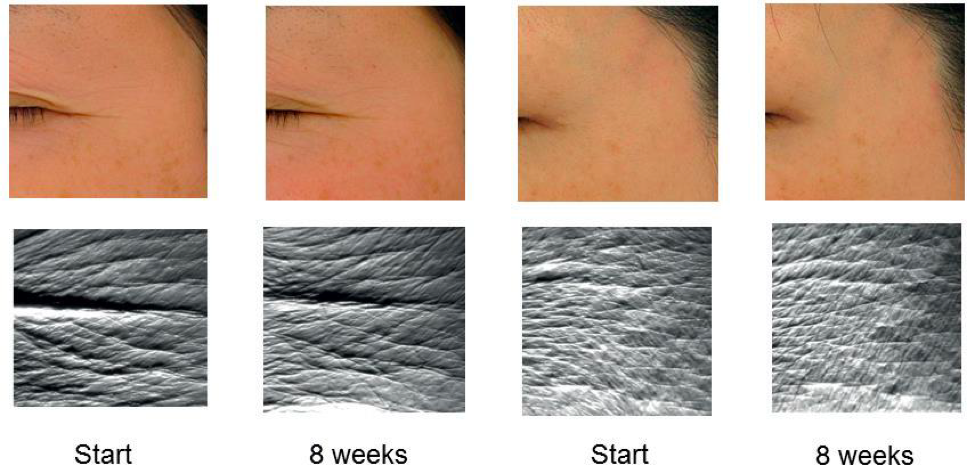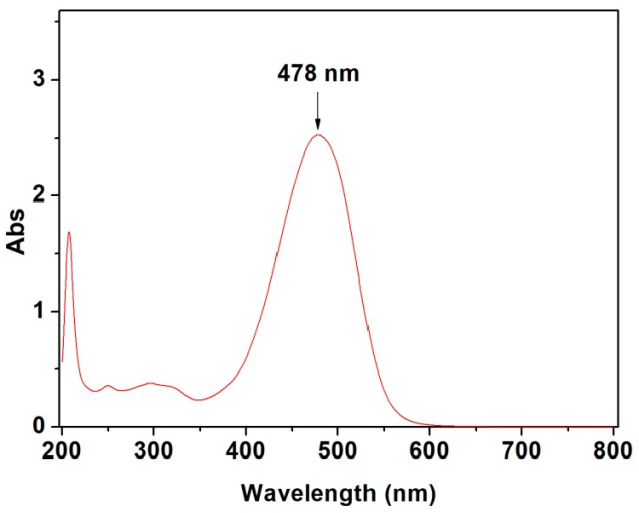1. Astaxanthin Overview
Where to buy Astaxanthin with lowering Astaxanthin price? Where to find information of wholesale Astaxanthin and Purchase Astaxanthin for sales? As Astaxanthin manufacturer & supplier, BFSTAR is your best choice.
Astaxanthin is a natural carotenoid, widely found in aquatic animals, bird feathers and micro algae. It has strong antioxidant activity. But because of its poor water solubility and stability, astaxanthin is very easy to be oxidized and decomposed when encountering light, heat, oxygen, etc., which reduces its bioavailability. BFSTAR develops astaxanthin water emulsion by nano-emulsification technology that overcomes the above shortcomings. Astaxanthin water emulsion is easily absorbed by skin, and still has a strong anti-oxidation property.
Transdermal tests have shown that astaxanthin water emulsion can change the tight structure of skin stratum corneum. It can promote the penetration and absorption of astaxanthin, and increase the retention of astaxanthin in skin. Cytotoxicity and skin irritation experiments proved that astaxanthin water emulsion has better safety at a certain concentration, and there is no obvious irritation to human skin.
As the strongest antioxidant agent in nature, astaxanthin’s antioxidant activity is 1000 times that of vitamin C. Astaxanthin can effectively protect the skin from ultraviolet (UVA, UVB) damage. Its super strong ability to eliminate free radicals can prevent skin cells from being damaged by free radicals, and reduce wrinkles and fine lines. As a super anti-oxidant agent for cosmetic, astaxanthin is widely used in various cosmetics such as cream, serum, eye cream, facial mask and lotion.
| Product Name | CAS Number | INCI Name | |
| Astaxanthin | 472-61-7 | ASTAXANTHIN | |
| Molecular Weight | Molecular Formula | Molecular Structure | |
| 596.84g/mol | C40H52O4 |
 |
|
| Product ID | Specification | Minimal Package | Minimal Order Quantity |
| BFSTAR170101 | 1% | 1KG | 1KG |
2. Astaxanthin Source
The source of astaxanthin is mainly divided into chemical synthesis and natural extraction. Astaxanthin is the final product of carotenoid synthesis, which is difficult to synthesize artificially and is mostly in cis structure. The US FDA only approves the trans-structure astaxanthin for industrial production. Natural extraction methods usually come from aquatic products, such as shrimp and crab shells, algae, etc.
Natural astaxanthin mainly comes from Haematococcus pluvialis. The content of astaxanthin in Haematococcus pluvialis is 1.5%-3.0%, which is regarded as a “concentrate” of natural astaxanthin. Haematococcus pluvialis is considered as the best organism to produce astaxanthin in nature.

3. Astaxanthin Manufacturer Specifications
| Product Name | Specification |
| Astaxanthin | 1% |
| Items | Specification |
| Assay | 1% |
| Appearance | Red or deep red liquid |
| Odor & taste | Slight algal smell, no corruption and other odors, no visible impurities |
| Physical Characteristics | |
| Methanol | ≤2000mg/Kg |
| 1,4-Dioxane | ≤30mg/Kg |
| Heavy Metals | |
| Pb | ≤1.0mg/Kg |
| Cd | ≤1.0mg/Kg |
| As | ≤1.0mg/Kg |
| Hg | ≤1.0mg/Kg |
| Microbiological Tests | |
| Total plate count | ≤1000cfu/g |
| Yeast & mold | ≤100cfu/g |
| Escherichia coli | Negative |
| Staphylococcus | Negative |
| Salmonella | Negative |
4. Astaxanthin Benefits
- Anti-oxidation & Anti-aging
The antioxidant activity of astaxanthin is equivalent to 10 times that of β-carotene and 550 times that of vitamin E. Astaxanthin can significantly reduce the damage of ROS and NMP to skin collagen and dermis elastin, thus ensuring the normal metabolism of skin. The structure of astaxanthin makes it easy to react with free radicals to scavenge free radicals, and play an anti-oxidant effect. Used in cosmetics, astaxanthin can prevent and delay skin aging and reduce the production of wrinkles and fine lines.

Figure. The anti-photo aging effect of astaxanthin

Figure. Positive results of astaxanthin for anti-wrinkle in 8 weeks
- Sun Block
Astaxanthin is a very effective photo-protective agent. It has its unique molecular structure. The absorption peak of its substance is about 470nm, which is similar to the UVA wavelength (380-420nm). Therefore, astaxanthin can absorb a large amount of UVA, which can effectively prevent ultraviolet radiation and eliminate free radicals caused by ultraviolet, thereby reducing the damage of ultraviolet rays to skin. In addition, astaxanthin can quickly restore skin damaged by UV burns.

Figure. Ultraviolet spectra of astaxanthin
5. Pharmacological Studies of Astaxanthin and Cosmetics
| Test Item | Concentration | Result |
| Elimination of free radical DPPH | 90μg/mL | Elimination rate: 95.0% |
| Elimination of hydroxyl radical | 40μg/mL | Elimination rate: 75.6% |
| Elimination of superoxide radical | 5μg/mL | Elimination rate: 70.5% |
| Elimination of singlet oxygen radical | 0.03% | Elimination rate: 34% |
| Inhibition of lipid peroxidation | 1mmol/L | Inhibition rate: 33%±2.1% |
| Inhibition of UV-damaged protein | 1mmol/L | Inhibition rate: 77.5% |
| Inhibition of NO production by cell culture | 5μmol/L | Inhibition rate: 47.5% |
| Inhibition of PEG2 production by cell culture | 10μmol/L | Inhibition rate: 31.4% |
6. BFSTAR Astaxanthin Characteristic
- BFSTAR adopts nano-emulsification technology, effectively solving the problems of poor water solubility and stability of astaxanthin.
- BFSTAR Astaxanthin is cosmetics grade and water-soluble; it is suitable for cosmetic formulation.
- BFSTAR Astaxanthin greatly increases the absorption efficiency and bio-availability.
- BFSTAR Astaxanthin can be soluble in water quickly, and without any precipitate.
7. Astaxanthin Reference Dosage
Astaxanthin is widely used in anti-aging and sun-protection skincare products, including facial mask, emulsion, essence, face cream, sunscreen, and other types of cosmetics.
| Product | Reference Dosage |
| Astaxanthin | 0.05%-0.5% |
Specifically, recommended dosage in toner is 0.1%, in lotion is 0.2%, in mask is 0.06%, in serum is o.25%, in cream is 0.4%.
8. Astaxanthin Uses and Application in Cosmetic
- Add it at room temperature and heat to above 40°C to speed up the dissolution rate.
- Astaxanthinis better to use with resveratrol in cosmetic formulation.
- Astaxanthin can compound with collagen or hyaluronic acid to prepare cream or serum.
- Store below 25℃ and away from light.
Astaxanthin application cases in major cosmetic brands
| Country | Brand | Product |
| China | Proya |
Elastic Brightening Youth Essence
No Wear Lasting Foundation |
| COGI | Hydrating Repairing Mask | |
| EASYFACE | Astaxanthin Hydra Repair Essence | |
| Zhiben | Total Solution Ultra-effective Serum | |
| Face Live | Nourishing Conditioning Mask | |
| Korea | Dermafirm |
Asta Lifting Vital Toner
Asta Lifting Vital Emulsion |
| RNW DER. |
Special Sleeping Mask
Deep Moisture Sleeping Mask |
|
| New Zealand | Coco Brownie |
Revitalizing & Repairing Serum
Skin Perfecting Lotion |
| France | Biotherm | Homme Age Fitness Anti-Aging Lotion |
9. Astaxanthin Reference Formula
Anti-aging Cream
| Ingredient | Content(%) | Ingredient | Content(%) |
| Astaxanthin | 0.2 | Soluble Eggshell Membrane | 0.5 |
| Hexadecyl Betaine | 0.5 | Squalane | 10.0 |
| White Wax | 5.0 | Hexadecanol | 4.0 |
| Span 60 | 2.0 | Tween 60 | 2.0 |
| Glycerin | 5.0 | Fragrance | 0.1 |
| Methyl 4-hydroxybenzoate | 0.1 | Deionized water | Add to 100 |
Sunscreen Lotion
| Ingredient | Content(%) | Ingredient | Content(%) |
| Astaxanthin | 0.5 | Hexadecanol | 8.0 |
| White oil | 4.5 | Isopropyl Palmitate | 4.5 |
| Simethicone | 1.5 | Polyethylene Glycol | 0.5 |
| Coconut Oil | 4.0 | SPP 200 | 2.5 |
| Preservative | 0.1 | Fragrance | 0.1 |
| Deionized water | Add to 100 |
10. Astaxanthin Safety
- Cosmetic, Toiletry &Fragrance Association (CTFA) has specifiedAstaxanthin as a cosmetics ingredient.
- Astaxanthinis included in The International Catalogue of Chinese Cosmetic Raw Materials Standards in 2010 issued by CAFFCI.
- Astaxanthin is listed On the Announcement of Name List of Cosmetics Raw Material published by CFDA in 2021. No reports show its insecurity.
11. Packing and Storage
Packing:
- Sample bottles are 30ml and 50ml glass bottles.
- The products in small batches are packed in 1kg, 5kg and 10kg PE bottles.
- The outer packing of large quantity products is 200L aluminum bucket with aluminum plastic compound bag inside.
Storage: Stored in a cool dry place and away from direct sunlight and oxidizing agents.


